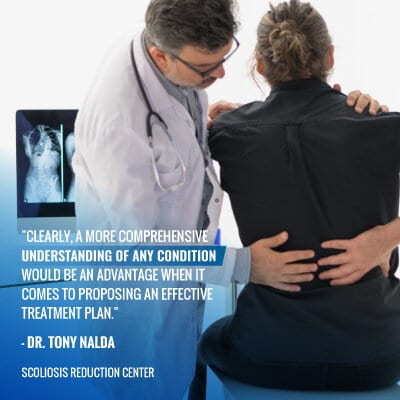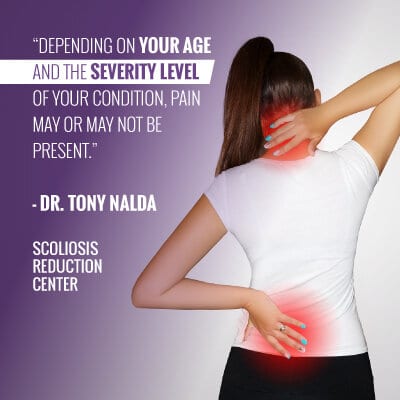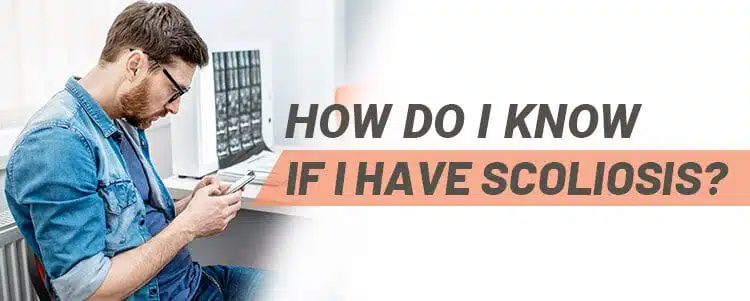If you’re questioning whether or not you have scoliosis, there are different ways to get the answers you’re looking for. Being proactive with your health is always the best choice. When it comes to scoliosis, paying attention to postural changes and a visit to a specialist are the best ways to find out if you have scoliosis.
When to See a Doctor
If a person’s concerned they might have scoliosis, it’s most likely because they’re experiencing signs and symptoms, such as postural changes or pain.
In many scoliosis cases, it’s nearly impossible to spot the condition early on; this is because it’s not until the condition progresses in severity that symptoms become evident.
For specialists and people looking for signs and symptoms of the condition, mild cases can be caught early on, but the majority of patients and their caregivers are average people who aren’t looking for those signs, or are unaware of how those subtle signs and symptoms appear.
Especially with progressive conditions like scoliosis, it can be highly beneficial to catch the condition early on so treatment can be started sooner than later.
As a doctor, I always say to people, if you’re worried about a potential medical issue, talk to a medical professional; there’s no harm in asking questions and being proactive with your health. If the exam and tests turn up nothing, there’s no harm done, but a condition left to progress unimpeded can be much harder to treat than one that is caught early on.
Why a Scoliosis Specialist is the Best Choice
When I say that a person should “go see a doctor” or “seek the help of a medical professional,” I want to be clear that if scoliosis is a concern, a scoliosis specialist is by far the best choice.

That’s not to say that a general practitioner couldn’t give you answers. As there is still so much mystery surrounding the condition, a specialist dedicated to studying and treating scoliosis is in the best position in a number of ways: knowing what symptoms to look for, experience reading scoliosis X-rays, offering the most comprehensive understanding of a patient’s condition, and establishing an effective treatment plan.
Clearly, a more comprehensive understanding of any condition would be an advantage when it comes to proposing an effective treatment plan. When it comes to scoliosis, a comprehensive understanding is essential as it not only has to take into account where the patient’s condition is at the time of diagnosis, but also what type of progression that patient is most likely to experience.
Scoliosis-Related Pain
What prompts most people to see a doctor or question what’s happening in their bodies is the presence of pain and discomfort. In scoliosis, pain is not always the best indicator.
For both adults and adolescents, if unexplained pain is present in the back, this is definitely time to seek out a specialist. If a person is experiencing scoliosis-related back pain, this suggests that the condition is on the moderate-to-severe scale.
Adolescents and Pain
For adolescents, which make up the bulk of scoliosis cases, pain is often not a pressing issue or symptom.
While growth and lengthening of the spine is still occurring, scoliosis can be relatively painless. In most cases, it’s not until the condition is quite severe that adolescents will experience scoliosis-related pain. In approximately 20 percent of idiopathic adolescent scoliosis cases, muscle pain can be present.
If you’re an adolescent experiencing postural changes, plus unexplained back or muscle pain, it’s time to see a scoliosis specialist for further testing.
Adults and pain
Adults with scoliosis experience pain quite differently. As they are no longer growing, the curvature causes compression on the spine and its surrounding nerves and tissues; this causes pain and discomfort.
With my adult patients, it’s most often pain that brings them in looking for answers, and with adult idiopathic scoliosis, pain is often expressed in areas of the body other than the back.

If you’re an adult experiencing postural changes coupled with pain in the back, feet, knees, or hips, scoliosis should be a concern and warrants further testing.
Depending on your age and the severity level of your condition, pain may or may not be present.
Recognizing Postural Changes
Soliosis diagnosis is given when a person’s X-ray shows an abnormal spinal curvature with a Cobb angle measurement of 10 degrees or more. The more a crooked spine twists and bends away from a straight alignment, the higher the Cobb angle measurement will be.
That measurement places the individual’s condition on a scale from mild to severe. Depending on the severity of the condition, related postural changes can be nearly impossible or easy to spot.
Postural Changes and Mild Scoliosis
If a person has received a mild scoliosis diagnosis, that means the measurement of their spinal curvature is 25 degrees or less. At this stage, symptoms such as pain and postural changes might not be evident.
Mild scoliosis is unlikely to present any major changes to your physical abilities. Most likely, you would still be able to participate in the sports and activities you’re used to and wouldn’t notice any decrease in mobility.
However, scoliosis is progressive, meaning the nature of the condition is to worsen over time, and this is why proactive treatment is so important. Of course, proactive treatment can’t be started until you know you have the condition, which is why early diagnosis and knowing what symptoms and postural changes to look for is so important.
Symptoms to look for:
- Clothing fitting unevenly
- Issues with balance and coordination
- Changes in gait
Postural Changes to look for:
- Uneven shoulders and hips
- Head appearing not centered on the body
- One arm appears to hang lower than the other
- Ribs protrude more on one side than the other
- Body appears to be tilting to one side when standing
- One leg appears longer than the other
- One hip appears to sit higher than the other
- An asymmetry to the waist where one side appears more rounded or flatter than the other
- One shoulder blade sticks out more than the other
- Space between arms and torso appears uneven
You can see how a spinal deformity can affect the body in multiple ways. The general rule of thumb is if you’re noticing more than two of the above postural changes or symptoms, or a general asymmetry of the body, scoliosis is a possibility.
Postural Changes and Moderate Scoliosis
If you’ve received a moderate-scoliosis diagnosis, your X-ray will show a Cobb angle measurement between 25 and 40 degrees.
People with moderate scoliosis make up the majority of scoliosis patients as this is when symptoms and postural changes become more obvious and are easier to diagnose. At this stage, it has progressed past the mild stage, and there is a large amount of data supporting the likelihood that the condition will continue to progress into the severe stage, if left untreated.
In my opinion, this is a critical treatment time as efforts need to be made to slow down or stop the condition’s progression before it reaches the severe stage.
Symptoms to look for:
- More obvious issues with clothing fitting unevenly
- More noticeable issues with balance and coordination
- A more extreme and noticeable change in gait
Postural changes to look for:
- The spinal deformity can be seen with the naked eye
- Ribs protruding more on one side than the other will become noticeable
- One shoulder blade protruding from the body more on one side than the other is noticeable
- Shoulders can seem asymmetrical with one sitting higher than the other
As you can see, signs of moderate scoliosis to watch for are more severe versions of the symptoms and changes associated with milder cases. The aforementioned postural changes are more obvious while bending forward, so if you suspect these changes, ask someone you trust to check for asymmetries while you bend forward. Get them to take pictures of asymmetries they notice so you can look too.
In general, it’s asymmetrical changes to the body that you should be looking out for.
Postural Changes with Severe Scoliosis
A person with a severe-scoliosis designation would have a Cobb angle measurement of 40-plus degrees for adolescents and 50-plus degrees for adults.
If a condition has progressed into the severe stage, the aforementioned symptoms and postural changes associated with the mild and moderate stages are heightened, more noticeable, and can be far more extreme.
At this stage, people notice changes to their physical abilities and can experience chronic pain. For adults who have stopped growing, severe scoliosis can cause daily pain and a marked decrease in mobility and flexibility.
It is also at this stage that I most notice the emotional and psychological effects of the condition. If you’ve noticed postural changes that set you apart from your peers and are causing you to have a negative self-image, or feel increasingly self-conscious about your appearance or walk, this is an additional sign of scoliosis.
Symptoms to look for:
- Impairments in lung function, especially during exercise
- Pain in the back, neck, or legs
- Difficulty sleeping
- Digestive issues
- Irregular menstrual cycles
- Challenges with balance and coordination
- Issues with proprioception (the body’s ability to recognize its position without visual cues)
Postural Changes to look for:
- Arms appearing to be different lengths
- One hip seeming to sit higher than the other
- Legs appearing to be different lengths
- Ribs protruding more prominently from one side of the body than the other
- Shoulder blades that protrude more prominently on one side of the body
- Arms that appear to be stuck to the sides of the body, rather than swinging naturally
Conclusion
Living with scoliosis means different things to different people. Factors such as age and where you fall on the condition’s severity scale determine what types of signs and symptoms you are likely to experience. These symptoms can range from subtle to extreme, which is why so many people are unaware they’re living with the condition.
In most cases, it’s not until a condition has progressed into the moderate and severe stages that individuals, and people in their lives, become aware that something wrong is happening in the body.
If you’re an adolescent wanting to know if you have scoliosis, the main signs and symptoms to look out for include: how your clothing hangs on your body, the way you walk, balance and coordination, and postural changes caused by the body’s asymmetry.
If you’re an adult wanting to know if you have scoliosis, in terms of signs and postural changes, the main symptoms to watch for are similar to those for adolescents, with the additional symptom of pain.
While some adolescents can experience scoliosis-related back or muscle pain, this is more likely in severe cases. Pain is a more reliable indicator of the condition for adults. Scoliosis-related pain for adults is most often expressed in the feet, legs, and hips; this is the result of the body’s asymmetry caused by the spine’s misalignment.
The bottom line is this: if you think you might have scoliosis because you are experiencing one or more of the aforementioned signs and symptoms, see a scoliosis specialist for concrete answers.
There’s no harm done if an exam and X-ray doesn’t produce a scoliosis diagnosis, but there is a lot of potential harm that can come from waiting passively while a condition worsens. This is especially true in the context of progressive conditions and effective treatment options.
Here at the Scoliosis Reduction Center®, I encourage every patient to advocate for themselves and be as proactive as possible by getting educated on the signs and symptoms to look for. My book Scoliosis Hope has a large section dedicated to what people and their loved ones need to know in order to spot the early signs of scoliosis.
While it’s never too late to start treatment, patients experiencing the most success in managing progression are those whose treatment started in the condition’s early stages.





